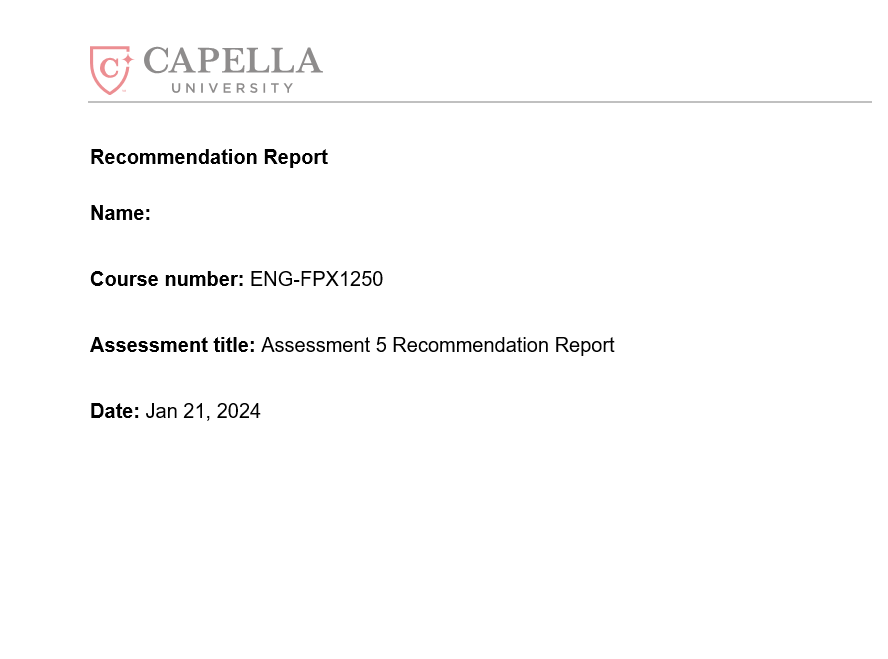Name:
Course number: ENG-FPX1250
Assessment title: Assessment 5 Recommendation Report
Date: Jan 21, 2024
Recommendation Report
Introduction
Telehealth provides opportunities for the nursing department to optimize care outcomes. A technologically-enhanced healthcare framework integrating services such as virtual consultations, remote patient monitoring, and mobile service provision reinforce the relevance of the nursing field in today’s world. Nurses can improve the relationship with patients, enhance client satisfaction, and make their organizations responsive to demands in today’s healthcare system. This report describes the need for the nurse manager to support the implementation of audio and video communication platforms that make it easy to monitor patients and respond to changes in symptoms. The wide range of practices and interactions between nurses and patients reinforce the need for the management to empower the nursing team to embrace telephone, video chats, and video conferencing to improve the safety and quality of patient care. The outcome pursued is the management’s initiative to allocate the resources required to implement telehealth.
Criteria
Successful implementation of telehealth promotes a patient-centered model that ensures better patient access to high-quality care while striving for optimal protection of safety and privacy. The criteria for implementing telehealth include accurate and complete estimation of the costs, focusing on data privacy and security risks, and the need to balance online with in-person consultations. The three appear in the order of their importance and portray the need for a systematic telehealth implementation process. One criterion for implementing telehealth is familiarizing with the cost of telehealth and its implications on the care outcomes. Notably, the nursing department requires investment in acquiring technical and human resources such as the software and hardware components, nurse educators, and audio and video tools required to link nurses with patients in remote locations.
The second criterion is focusing on regulations and guidelines on data privacy, confidentiality, and privacy. The risks of cyber-attacks and irresponsible sharing of protected health information reinforce the need for the nursing leaders and team to familiarize themselves with data protection rules and individual and collective efforts required to optimize data protection (Hwei & Octavius, 2021). For instance, the care team should understand the provisions of policies such as the Health Insurance Portability and Accountability Act that facilitate the effective adoption of telehealth in nursing practice. Adherence to regulations and guidelines on safe information exchanges enhances the quality of interdisciplinary collaboration associated with telehealth. In this case, nurses avoid discussing a patient’s details or sharing sensitive information without the client’s consent.
A third criterion is considering complementing telehealth with in-person care. The goal is to address the limitation of inadequate examination of physical examination by integrating options such as home visits and regular face-to-face sessions to improve the quality of telehealth. The various criteria guide the implementation team to address weaknesses that may limit the organization from gaining through improved patient education, interdisciplinary collaboration, and reduced costs (Hwei & Octavius, 2021). While telehealth offers an opportunity to scale remote care and patient education, nurses may still need to provide patient-centered and outcome-based care characterized by resilience in meeting individuals to discuss symptoms, prognosis, and alignment of the treatment plan with patients’ needs and expectations (Gajarawala & Pelkowski, 2019). Thus, healthcare professionals may consider linking patients to primary care providers and specialists operating near a community. The linkage provides the foundation for achieving efficiencies in terms of responding to the demand for online and in-person sessions with patients from remote locations.
Recommendation
The nursing department should proceed to embrace telehealth to help the workforce optimize quality and safety outcomes. The cost, data privacy, and relevance of in-person care provide insights into the viability of the technology. In this case, addressing the issues paves way for the successful implementation of telehealth that aligns with the organization’s strategic interests. The risk-benefit analysis reveals that the gains outweigh limitations, considering an opportunity for the nursing team to stay ahead of the learning curve. Modern nursing practices require the nurses to understand and respond positively to technologies such as telehealth that significantly boost the quality and safety of patient care (Burroughs et al., 2021). For instance, adopting the technology would help the facility reduce the cost of care through reduced risk of readmissions, emergency care visits, and delayed diagnosis and treatment.
Similarly, the existence of other information systems makes the organization prepared to handle information security, privacy, and confidentiality threats. The experience and technical expertise are enough to reinforce the nurses’ ability to initiate and maintain interdisciplinary collaboration and provide the best services to patients in remote locations (Gajarawala & Pelkowski, 2019). Further, there are concerns over the implications of telehealth on in-person care. However, the technology effectively promotes patient education, which is ideal for improving outcomes through self-management and timely response to undesirable outcomes. Telehealth also addresses the limitations of conventional face-to-face practices by ensuring that patients and healthcare professionals have access to timely and complete details about a disease and the appropriate treatment plan (Burroughs et al., 2021). Additionally, nurses are responsible for reducing health disparities by protecting patients from the high cost of care. In this sense, telehealth reduces travel times to enable patients to access patient-centered and outcome-based services from their preferred location.
Citations
Burroughs, M., Urits, I., Viswanath, O., Simopoulos, T., & Hasoon, J. (2021). Benefits and shortcomings of utilizing telemedicine during the COVID-19 pandemic. https://www.tandfonline.com/doi/full/10.1080/08998280.2020.1792728
Gajarawala, S., & Pelkowski, J. (2019). Telehealth benefits and barriers. The Journal for Nurse Practitioners, 17(2), 218-221. https://www.ncbi.nlm.nih.gov/pmc/articles/PMC7577680/pdf/main.pdf
Hwei, L. R., & Octavius, G. S. (2021). Potential advantages and disadvantages of telemedicine: A literature review from the perspectives of patients, medical personnel, and hospitals. Journal of Community Empowerment for Health, 4(3), 180-186. https://journal.ugm.ac.id/jcoemph/article/view/64247

